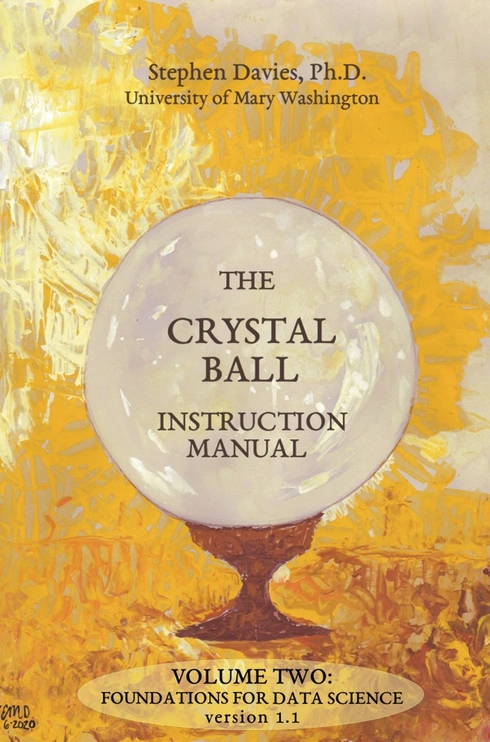
The Crystal Ball Instruction Manual Volume Two: Foundations For Data Science
No ratings
Stephen Davies, University of Mary Washington
Copyright Year:
Last Update: 2024
Publisher: University of Mary Washington
Language: English
Formats Available
Conditions of Use
![]() Attribution-ShareAlike
Attribution-ShareAlike
CC BY-SA
Table of Contents
- Intermission and review
- Navigating the Spyder’s web
- EDA: review and extensions
- KDEs and distributions
- Random value generation
- Synthetic data sets
- JSON (1 of 2)
- JSON (2 of 2)
- LOWESS
- Data fusion
- Long, wide, and “tidy” data
- Dates and times
- Using logarithms
- Accessing databases
- Screen scraping (1 of 2)
- Screen scraping (2 of 2)
- Probabilistic reasoning
- Causality
- Naïve Bayes (1 of 3)
- Naïve Bayes (2 of 3)
- Naïve Bayes (3 of 3)
- APIs
- kNN (1 of 2)
- kNN (2 of 2)
- Two key ML principles
- Feature selection
- Association Analysis
- “Special” data types
About the Book
Welcome to Volume Two of the Crystal Ball series: Foundations for Data Science! I titled the first volume “Introduction to Data Science” because it led you through a dip-your-toes-in-the-water experience. You took a brief tour through the various elements in this diverse field and got a feel for what it was all about.
Since you’re still reading, this means you’re still interested, and ready to explore the next level. In Foundations, we’ll solidify your growing knowledge so that you have a firm base on which to build everything else. Future volumes in this series will cover applications, advanced techniques, and some special data types that require special treatment. But it all ultimately rests on the skill set you’ll have built in Volumes One and Two of this series.
About the Contributors
Author
Stephen Davies, Associate Professor of Computer Science, earned a Ph.D. (2005) in Computer Science from the University of Colorado, Boulder, after having received an M.S. (1995) in Electrical Engineering from Colorado and a B.S. (1992) in Electrical Engineering from Rice University. He joined the UMW faculty in 2006, and has taught courses in database schema theory, Web application development, computational science, data mining, and object-oriented analysis & design, among other topics.
